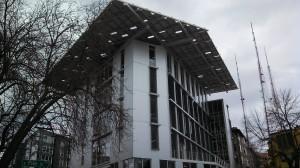
The Bullitt Center in Seattle, the world’s greenest office building.
Seattle is abuzz with the pending opening on Earth Day (April 22) of the Bullitt Center, which is considered to be the world’s greenest commercial building. This groundbreaking structure incorporates a diverse range of green energy technologies, sustainable and energy-efficient materials, and creative engineering and designs all intended to make the building’s footprint environmentally neutral. When fully operational, the Bullitt Center’s systems are anticipated to generate all energy and water (including through collecting rainwater) required to meet its needs, compost all toilet waste generated, use 75 percent less energy than average buildings, and even feed excess electricity generated by the rooftop solar panels back into the grid.
The Bullitt Center is the vision and new home of the Bullitt Foundation, a leading Seattle philanthropic organization committed to promoting sustainable practices and protecting the Pacific Northwest environment. Other confirmed tenants at time of writing include the University of Washington Integrated Design Lab and the International Living Future Institute, which developed the Living Building Challenge that the Bullitt Foundation aspires to realize through the Center. The purpose of the Living Building Challenge is to eliminate the distance between ideal solutions for developing the most sustainable buildings and communities, and the existing capabilities to achieve these solutions. The Bullitt Center, located at the intersection of two major thoroughfares in a neighborhood undergoing significant revitalization, is currently seeking additional tenants who share its vision.
The question of tenants in the Bullitt Center is an important one, for achieving the ambitious goals set forward for the achieving the Center’s zero-impact target requires the active participation of everyone in the building. A recent Seattle Times article about the Center outlines the commitments that prospective tenants must agree to in order to rent office space there. Some of these include managing energy and water use within annual “budgets” identified by the center; positioning every employee’s desk within 30 feet of a window to ensure access to natural light and fresh air; not using any office furnishings that include toxic components; using the staircase instead of elevator; and opening some of their office space to the public on Earth Day each year for educational purposes. Additionally, with no parking on site, Center occupants and visitors will need to walk, bike, or use public transit to get there. While some people may find these and similar rules restrictive, each has its benefits–both for Center tenant firms and organizations, and for their employees’ health and well-being. For example, as noted in the Seattle Times article, if Center tenants do not exceed their annual budgets, then none will pay an electricity bill. Offsetting the lack of parking is the Center’s location along major city bus routes, and five blocks away from a new streetcar station scheduled to enter into operation in 2014.
The Bullitt Center is an exciting test bed for some of the most cutting-edge green building designs and systems developed to date. Their performance once the building is fully operational will undoubtedly offer models and experience that will benefit future such projects. Just as important, though, is the Center’s role as a laboratory for how successfully people will function in an office environment requiring their active engagement as partners in enabling the building design to achieve its sustainability goals.
Image by Author




